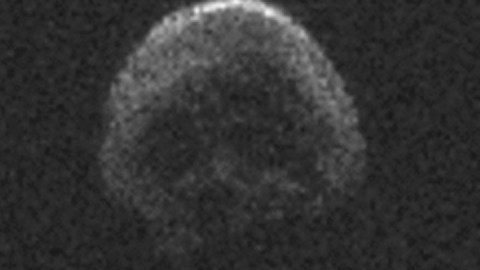Skull-shaped ‘Death Comet’ to soon pass Earth

Image: NASA
- The asteroid, named 2015 TB145, made its last flyby on October 31, 2015.
- Some scientists think the asteroid is a dead comet.
- Astronomers say there’s no chance it’ll collide with Earth, though it’ll make a closer approach in 2088.
An asteroid that resembles a human skull will fly past Earth after Halloween this year.
The asteroid — whose nicknames include “Death Comet” and “Great Pumpkin,” among others — was first discovered in October 2015 by astronomers using the Pan-STARRS1 telescope in Hawaii shortly before it flew past Earth on October 31, 2015.
During that pass, the asteroid, officially called 2015 TB145, came nearly 300,000 miles away from Earth, which is about 60,000 miles farther than the moon’s orbit. NASA wrote at the time that the passing marked “the closest currently known approach by an object this large until asteroid 1999 AN10, at about 2,600 feet (800 meters) in size, approaches at about 1 lunar distance (238,000 miles from Earth) in August 2027.”

NASA
A farther flyby
On November 11, 2018, the Death Comet is expected to pass Earth at the much farther distance of 24 million miles away. But with a diameter of just 2,000 feet, it’ll be too small and distance to see with the naked eye. Some scientists think the asteroid, which passes Earth every 3.04 years, could be a dead comet. That is, its volatiles may have been stripped over time from the heat of the sun.
“We found that the object reflects about six percent of the light it receives from the sun,” Vishnu Reddy, a research scientist at the Planetary Science Institute, said in a 2015 news release. “That is similar to fresh asphalt, and while here on Earth we think that is pretty dark, it is brighter than a typical comet which reflects only three to five percent of the light. That suggests it could be cometary in origin ― but as there is no coma evident, the conclusion is it is a dead comet.”

Image: NASA
Although the Death Comet is classified as potentially hazardous, astronomers say there’s no chance it’ll collide with Earth. In 2088, the Death Comet is expected to make another (relatively) close flyby at a distance of 5.4 million miles.





